
ESA Top Multimedia
Ariane 6 tests towards first flight
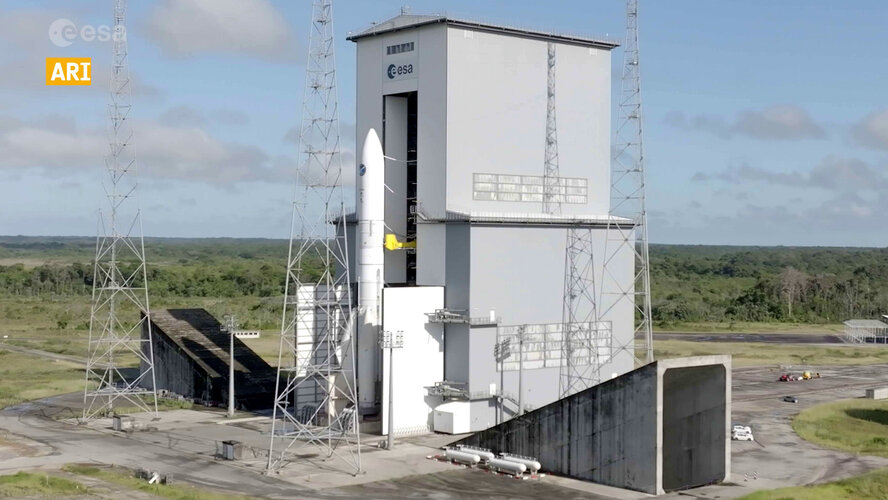
Europe’s next rocket, Ariane 6, passed all its qualification tests in preparation for its first flight, and the full-scale test model has been removed from the launch pad to make way for the real rocket that will ascend to space.
The test model at Europe’s Spaceport in Kourou, French Guiana, stood 62 m high. It is exactly the same as the ‘production model’ Ariane 6 rockets that will soon be launched, except that its boosters do not need to be tested as part of the complete rocket, so the boosters are not fuelled.
Teams preparing Ariane 6 for its inaugural flight successfully completed for the first time a launcher preparation and countdown sequence, on 18 July. Representatives of ESA, Ariane 6 prime contractor ArianeGroup and launch base prime contractor and test conductor CNES completed important objectives for system qualification and performed a series of actions fully representative of a launch chronology.
The launch simulation included the removal of the mobile gantry, the chill-down of ground and launcher fluidic systems, the filling of the upper and core stage tanks with liquid hydrogen (–253°C) and liquid oxygen (–183°C), and at the end of the test, the successful completion of a launch chronology up to the ignition of the Vulcain 2.1 engine thrust chamber by the ground system.
On 5 September 2023 the Vulcain 2.1 engine was ignited, fired for four seconds as planned and switched off before its liquid oxygen and liquid hydrogen fuels were drained to their separate underground tanks. The exercise showed again that the system can be kept safe in the event of a launch abort, as already demonstrated during the 18 July test.
A nighttime full-scale wet rehearsal for Ariane 6 was completed on 24 October 2023, the rocket was fuelled and then drained of its fuel. The test lasted over 30 hours with three teams working in shifts of 10 hours each.
A major full-scale rehearsal was conducted on 23 November 2023 in preparation for its first flight, when teams on the ground went through a complete launch countdown followed by a seven-minute full firing of the core stage’s engine, as it would fire on a launch into space.
A third combined test loading occurred on 15 December 2024 that included a launch countdown to qualify the launch system in degraded conditions and ensure its robustness in preparation for operations. This test sequence included qualification tests of several launch system functions in case of aborted launch and included one ignition of the Vulcain 2.1 engine thrust chamber. It was the fifth countdown run to include loading Ariane 6 with cryo-propellants since July.
On 30 January 2024, the cryogenic connection system passed a last system test of the liftoff disconnection operations lines – the yellow arms supporting the fuel lines to the upper stage to power the Vinci orbital engine. Simultaneously at the bottom of the central core the connection system for the main stage also disconnected.
On 5 February, it was the turn of the electrical umbilical lines to be disconnected. These lines supply the launcher and the satellites inside Ariane 6 with electrical power but also host the digital signals for communications with the informatics system as well as carrying sensor information to ensure the flight system is in good shape for liftoff.
The largest components for the first flight model of Europe’s new rocket Ariane 6 arrived at the port of Pariacabo in Kourou, French Guiana on 21 February 2024 via the novel ship, Canopée (canopy in French). The Ariane 6 stages and components are all manufactured across Europe.
The two central stages for Ariane 6’s first flight were then assembled in the launcher assembly building (BAL) at Europe’s Spaceport. The core stage and the upper stage for Europe’s new rocket Ariane 6 are set to fly in the Summer of 2024. Once assembled, the stages will be transferred to the launch pad.
Arctic Weather Satellite undergoing final tests
 Arctic Weather Satellite undergoing final tests
Arctic Weather Satellite undergoing final testsEpisode 1 – Scouting the Red Planet
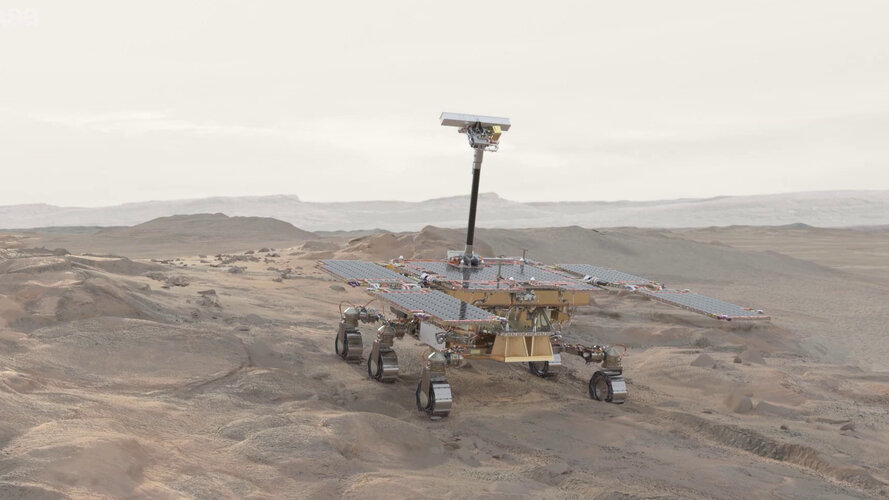
Watch the first episode of the ExoMars Rosalind Franklin rover mission – Europe’s ambitious exploration journey to search for past and present signs of life on Mars.
This episode starts after a successful descent and landing on the Red Planet in 2030.
Rovers on Mars have previously been caught in loose soils, and turning the wheels dug them deeper, just like a car stuck in sand. To avoid this, Rosalind Franklin has a unique wheel-walking locomotion mode to to overcome difficult terrains, as well as autonomous navigation software.
A major goal of the mission is to understand the geological context and identify minerals formed in the presence of water that could be good targets for drilling into and collecting samples for analysis.
The scientific eyes of the rover are set atop the mast on the Panoramic Camera suite, known as PanCam. From its vantage point about two metres above the ground, PanCam cameras come into play to get a whole picture of the site with high resolution imaging.
Enfys, meaning rainbow in Welsh, is an infrared spectrometer to study mineral composition. Enfys and PanCam work in synergy. PanCam is used to obtain colour, visual information of what lies around the rover. Enfys’ job is to inform scientists what the minerals are.
Rosalind Franklin will be the first rover to reach a depth of up to two metres deep below the surface, acquiring samples that have been protected from surface radiation and extreme temperatures.
The mission will serve to demonstrate key technologies that Europe needs to master for future planetary exploration missions.
This episode shows the spacecraft, the rover and martian landscapes are as true to reality as possible for a simulation.
Check ESA’s ExoMars website and our frequently asked questions for the latest updates.
Credits:
Production: Mlabspace for ESA
3D animation: ESA/Mlabspace
Video footage: ESA/NASA, Shutterstock
Music composed by Valentin Joudrier
Slider Tool (Webb NIRCam images)
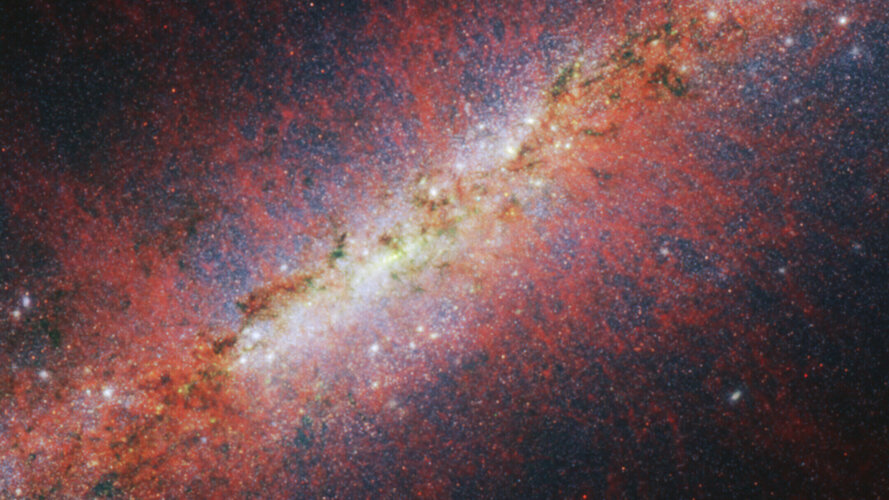
The NASA/ESA/CSA James Webb Space Telescope has set its sights on the starburst galaxy Messier 82 (M82), a small but mighty environment that features rapid star formation. By looking closer with Webb’s sensitive infrared capabilities, a team of scientists is getting to the very core of the galaxy, gaining a better understanding of how it is forming stars and how this extreme activity is affecting the galaxy as a whole.
Located 12 million light-years away in the constellation Ursa Major, this galaxy is relatively compact in size but hosts a frenzy of star formation activity. For comparison, M82 is sprouting new stars 10 times faster than the Milky Way galaxy.
These images were taken from Webb’s NIRCam (Near-Infrared Camera) instrument. The image on the left features longer wavelengths, and the image on the right features shorter wavelengths.
The first image reveals that red filaments trace the shape of the cool component of the galactic wind via polycyclic aromatic hydrocarbons (PAHs). PAHs are very small dust grains that survive in cooler temperatures but are destroyed in hot conditions. The structure of the emission is similar to that of the ionised gas, suggesting PAHs may be replenished from cooler molecular material as it is ionised.
This second image shows M82’s galactic wind via emission from sooty chemical molecules known as polycyclic aromatic hydrocarbons (PAHs). PAHs are very small dust grains that survive in cooler temperatures but are destroyed in hot conditions. The structure of the emission resembles that of hot, ionised gas, suggesting PAHs may be replenished by continued ionisation of molecular gas.
Saharan dust plume
Information session on the outcome of ESA's 323rd Council
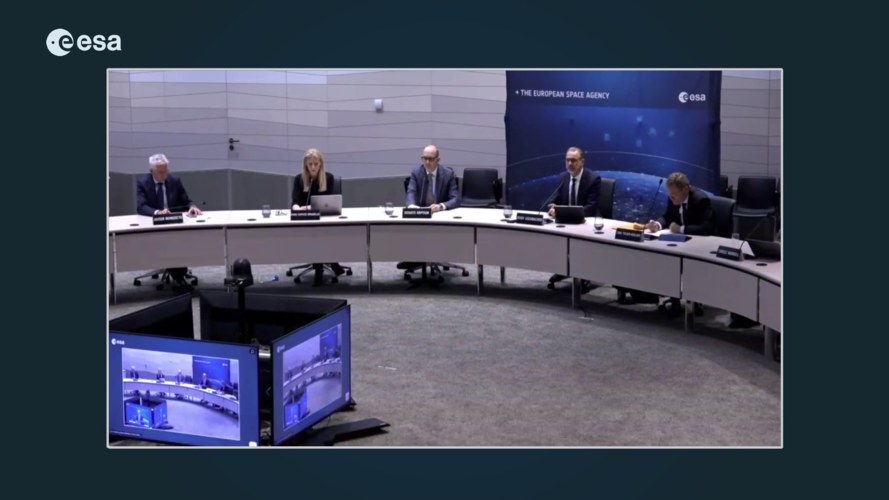
ESA Member States met in Paris, France, for the 323rd session of the ESA Council on 26 and 27 March 2024.
Watch the replay of the information session in which ESA Director General Josef Aschbacher and ESA Council Chair Renato Krpoun share the outcome of the meeting. They gave an update to media about ESA's vision for the European space sector by 2040 and the status of actions provided in the roadmap for the implementation of the Resolution on present and future European Space Transportation.
They also addressed the progress made in addressing critical challenges faced by ESA in preparation for the next Ministerial Council in 2025. This includes the establishment of the Independent Project Management Authority (IPMA), updating procurement and geo-return rules, service procurement and agreements with Member States.
ESA School Days 2024 at ESRIN

Dall’11 al 15 marzo, oltre 1.400 giovani studenti e studentesse si sono ritrovati al Centro ESA a Frascati, dedicato all’Osservazione della Terra, per l’edizione 2024 degli ESA School Days. Il Centro ESRIN ha accolto le scuole primarie (quarta e quinta classe) nei giorni 11, 12 e 13 marzo, mentre gli ultimi due giorni della settimana sono stati dedicati alle scuole medie. Durante cinque giorni di presentazioni e laboratori pratici, le scuole provenienti da tutta Italia hanno avuto l’opportunità di esplorare la vasta gamma di attività spaziali che si svolgono nel sito dell’ESA.
L’iniziativa, che ha visto la partecipazione di ESERO Italia e dell’Agenzia Spaziale Italiana (ASI), si propone l’obiettivo di coinvolgere e ispirare le prossime generazioni di studenti e studentesse STEM, diffondendo conoscenza sullo Spazio e sull’Agenzia Spaziale Europea.
From 11 to 15 March, over 1400 young students gathered at ESA Centre for Earth Observation in Frascati for the 2024 edition of ESA School Days. ESRIN welcomed primary school students (4th and 5th grades) on 11, 12 and 13 March, while the last two days were dedicated to secondary schools. During these five days of presentations and laboratories, schools from across Italy had the opportunity to explore the wide range of space activities carried out at ESA’s establishment.
The initiative, that saw the participation of ESERO Italia and the Italian Space Agency (ASI), aims to engage and inspire the next generation of STEM students, while sharing knowledge about space and the European Space Agency.
Oxia Planum geological map

A team of European scientists have published the most detailed geologic map of Oxia Planum – the landing site for ESA’s Rosalind Franklin rover on Mars. This thorough look at the geography and geological history of the area will help the rover scout the once water-rich terrain, in the search for signs of past and present life.
The map gives scientists a head start before Rosalind Franklin lands there in 2030. Four years in the making, this map identifies 15 geological units with characteristic features that can help decide how the rover explores the area, interprets its surroundings, and tries to collect evidence of primitive life.
Oxia Planum is located near the martian equator and contains sedimentary deposits that are nearly four billion years old.
The map includes the main types of bedrock, and structures with distinct shapes like ridges and craters. It even features the material that rests on top, for example blown by the wind, or thrown long distances when meteorites impacted the surface. The shape model of the surface on which the map is shown here was generated from orbital images by a painstaking process. In some places, long and straight ‘stripes’ can be seen as a result of this processing.
Data came from the Colour and Stereo Surface Imaging System (CaSSIS) onboard the ExoMars Trace Gas Orbiter and several instruments on NASA’s Mars Reconnaissance Orbiter (MRO), including the HiRISE camera, which returns images from Mars orbit at 25 cm per pixel.
For more information, visit the ExoMars website: www.esa.int/exomars.
Toward the next generation of air quality monitoring

Air pollution is the largest environmental health risk in Europe and significantly impacts the health of the European population, particularly in urban areas.
Following on from the Sentinel-5P satellite – the first Copernicus mission dedicated to monitoring our atmosphere – the Sentinel-4 and Sentinel-5 missions will take current air quality measuring capabilities to the next level.
Together, the Sentinel-4 and -5 missions will provide information on atmospheric variables in support of European policies. This will include the monitoring of air quality, stratospheric ozone and solar radiation, and climate monitoring.
This video features interviews with Giorgio Bagnasco, Sentinel-4 Mission Project Manager, Ben Veilhelmann, Sentinel-4&5 Mission Scientist and Didier Martin, Sentinel-5 Mission Project Manager.
Simulation of a Milky Way-like galaxy forming

This simulation shows how a galaxy like the Milky Way forms and evolves through time. It runs from the birth of the Universe (13.7 billion years ago) to 3 billion years ago.
The forming galaxy begins as a clump of dark matter threads that knit together; gas and stars then begin to form along these bright veins as time ticks on. A major event in the Milky Way’s history is also labelled at around one minute in, when another object collided with the infant Milky Way.
Gas is shown in blue, stars in white, dark matter in red, and iron in green, as indicated by the labels displayed at bottom left. In the bottom right, the amount of time ago is shown via both the ‘z’ label (referring to redshift), and the ‘GYR’ label (with 1 Gyr, or gigayear, equalling 1 billion years).
The simulation was produced by Florent Renaud as part of his Vintergatan Project (Vintergatan being the Swedish word for ‘Milky Way’, meaning ‘The Winter Street’).
Deforestation near Santa Cruz de la Sierra, Bolivia

This animation shows deforestation near Santa Cruz de la Sierra, Bolivia. The images were acquired over the course of four years: 2 July 1986, 16 July 1991, 13 August 2007 and 10 August 2022.
Because of their unique perspective from space, Earth observation satellites are instrumental in providing comprehensive information on the full extent and rate of deforestation, which is particularly useful for monitoring remote areas.
Andreas Mogensen at Ellington

ESA astronaut Andreas Mogensen stepping out of the plane at Ellington Field, Texas, US after splashing down with Crew-7 earlier that day.
ESA astronaut Andreas Mogensen flew with his Crew-7 crewmates Jasmin Moghbeli (NASA), Satoshi Furukawa (JAXA), and Konstantin Borisov (Roscosmos) to Ellington Field near Houston, Texas, US, after spending six months on the International Space Station and returning to Earth in the Dragon Endurance.
Crew-7 splashed down off the coast of Florida, US, close to Pensacola, at 09:47 GMT/10:47 on 12 March 2024, following a nearly 19-hour journey after undocking from the Space Station.
Andreas spent 199 days in space during his Huginn mission, 197 of them on the Space Station. During this time, he conducted more than 30 European experiments and technology demonstrations, as well as many international ones. From filtering waste water and figuring out astronauts’ sleep in space, to capturing the image of a special lightning called a red sprite, Andreas shared the science he conducted with the world through his social media, l like the mythical bird that gave its name to his mission
Huginn is named after one of the two ravens of the Norse god Odin, the other being Muninn. According to Norse mythology, the two ravens are said to fly into the world every day, gathering information and relaying it to Odin at the end of the day, telling him what they have seen across the globe.
Taking Earth’s temperature from space

Climate change exacerbates droughts by making them more frequent, longer, and more severe. This can have a wide range of impacts on the environment, agriculture, ecosystems and communities including water scarcity, crop failure and food shortages.
The upcoming Copernicus Land Surface Temperature Monitoring, LSTM, mission will improve sustainable agricultural productivity in a world of increasing water scarcity and variability.
The mission will carry a high spatial-temporal resolution thermal infrared sensor to provide observations of land-surface temperature.
These data are key to understand and respond to climate variability, manage water resources for agricultural production, predict droughts and also to address land degradation.
LSTM is one of six Copernicus Sentinel Expansion missions that ESA is developing on behalf of the EU. The missions will expand the current capabilities of the Copernicus Space Component – the world’s biggest supplier of Earth observation data.
This video features interviews with Ana Bolea Alamanac, LSTM Mission Project Manager, Ilias Manolis, LSTM Mission Payload Manager and Itziar Barat, LSTM Mission System and Operations Manager.
The return of Andreas Mogensen | Huginn Mission

After more than 6 months on the International Space Station, ESA astronaut Andreas Mogensen returned to Earth, marking the end of his Huginn mission. It was his second mission to the Space Station and his first long-duration, where he was the pilot of Crew-7, which consisted of Jasmin Moghbeli (NASA), Satoshi Furukawa (JAXA), and Konstantin Borisov (Roscosmos).
Thumbs up from Andreas Mogensen

ESA astronaut Andreas Mogensen after exiting the Dragon Endurance, that brought him and Crew-7 back from the International Space Station. Andreas was on his Huginn mission, his second space flight, and his first long-duration mission to the International Space Station.
Andreas Mogensen and Crew-7 in Dragon after return to Earth

ESA astronaut Andreas Mogensen together with Crew-7 after their return to Earth. The Dragon splashed down at 09:47 GMT/10:47 CET on 12 March after undocking from the International Space Station on 11 March at 15:20 GMT/16:20 CET.
From left to right: Konstantin Borisov, Andreas Mogensen, Jasmin Moghbeli, and Satoshi Furukawa.
The Whispering of Huginn
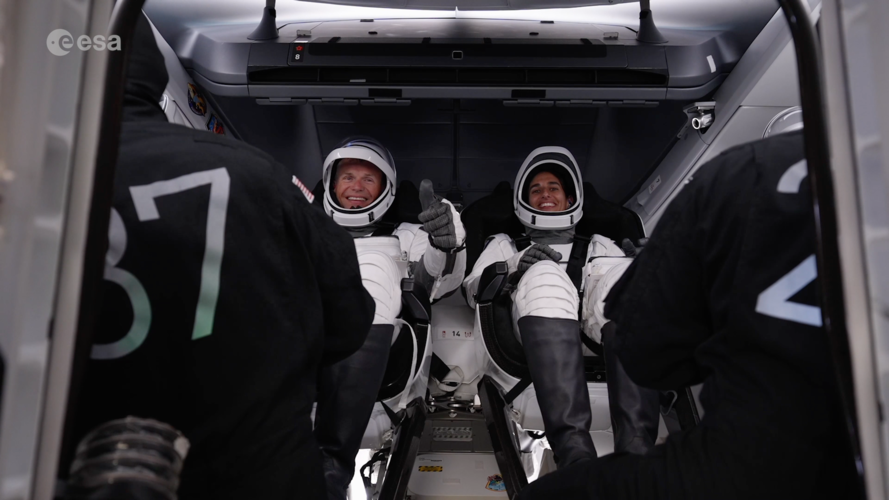
Andreas Mogensen launched on his Huginn mission in August 2023 to the International Space Station, becoming the first non-US astronaut to pilot SpaceX’s Crew Dragon spacecraft. Andreas became commander of the International Space Station in September 2023, becoming the longest serving European commander in January 2024. His mission was spent on more than 30 European experiments and plenty of international ones as well, ranging from water purification to studies of human physiology and thunderclouds. After 6 months on the International Space Station, Andreas will come down to Earth together with his Crew-7 crewmates Jasmin Moghbeli (NASA), Satoshi Furukawa (JAXA), and Konstantin Borisov (Roscosmos).
Virtual Reality for body and mind
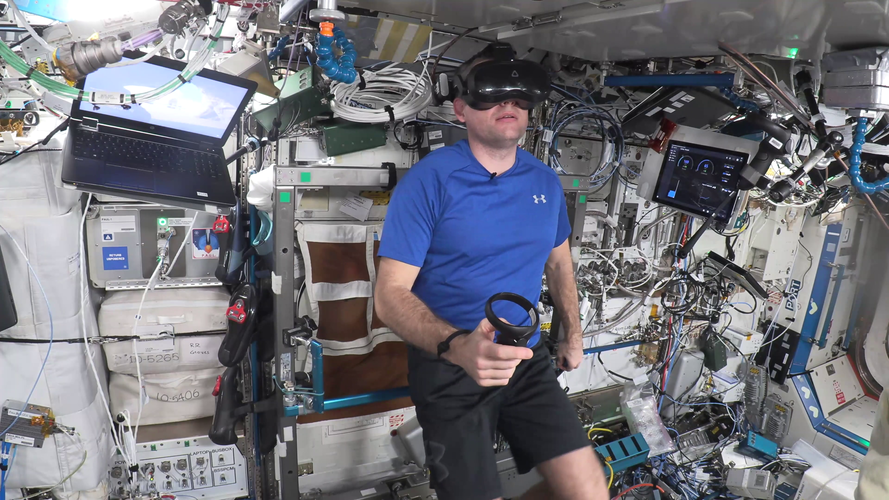
ESA astronaut Andreas Mogensen explains how two experiments involving virtual reality makes on International Space Station. The first is Virtual Assistance Mental Balance (VAMB) where Andreas gets to enjoy a calm setting in nature that helps him relax. The second one is VR for Exercise, where he cycles on the Space Station’s exercise bike and through different bike routes in Denmark on the VR headset, which has quickly become a favourite for Andreas.
Andreas Mogensen and Marcus Wandt in Columbus
 Two Scandinavians in space
Two Scandinavians in spaceMuninn Mission highlights
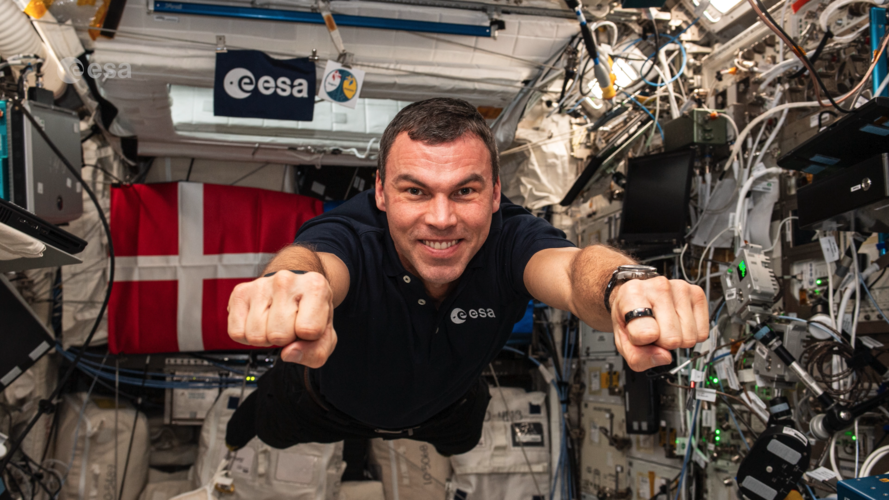
Highlights of the Muninn mission with ESA project astronaut Marcus Wandt, from the countdown to launch, to his work on the International Space Station and the return to Earth.
Axiom Mission 3 crew in space

Axiom Mission 3 crew in the European-built Cupola on the International Space Station. Clockwise, ESA project astronaut from Sweden Marcus Wandt, Walter Villadei from Italy, Alper Gezeravcı from Türkiye and Michael López-Alegría, a dual US-Spanish citizen.
Two Scandinavians in space
 Two Scandinavians in space
Two Scandinavians in spaceEarth views from Cupola by Marcus Wandt

Join ESA project astronaut Marcus Wandt inside the seven-windowed cupola, the International Space Station's "window to the world".
The ESA - European Space Agency-built Cupola is the favourite place of many astronauts on the International Space Station. It serves not only as a unique photo spot, but also for observing robotic activities of the Canadian Space Agency's robotic arm Canadarm2, arriving spacecraft and spacewalks.
Marcus was launched to the International Space Station on the Dragon spacecraft as part of Axiom Mission 3 on 18 January 2024. His two-week mission on board is known as Muninn.
Follow Marcus’s journey on the Muninn website, check our launch kit in English or Swedish and connect with Marcus on his Instagram and X accounts.
Full house
 Full house
Full houseMarcus and Muninn are flying

ESA project astronaut Marcus Wandt took off on 18 January 2024 as part of the Axiom-3 crew for a 14-day mission to the International Space Station. After 36 hours catching up to the Space Station, the Dragon docked to the Space Station, the seal between the two tested and finally Marcus started his Muninn mission as he entered the International Space Station. ESA astronaut Andreas Mogensen along with the rest of the crew of Expedition 70 was waiting to welcome them to space!
Muninn spreads its wings

ESA project astronaut Marcus Wandt launched together with the rest of the Axiom-3 crew at 22:49 CET on 18 January 2024, from launch pad 39A, NASA's Kennedy Space Center, Florida, USA.
Marcus will start his Muninn mission when he enters the International Space Station on Saturday 20 January, where he will spend up to 14 days conducting science and testing technology that can one day help people on Earth.
You can follow Marcus mission on his social media:
https://twitter.com/astro_marcus
https://www.instagram.com/esaastro_marcus/
And learn more about his Muninn mission on ESA Muninn page:
https://www.esa.int/Science_Exploration/Human_and_Robotic_Exploration/muninn
Liftoff of Axiom Mission 3
 Liftoff of Axiom Mission 3
Liftoff of Axiom Mission 3Axiom Mission 3 crew arrival for launch
Rocket ready for Axiom Mission 3
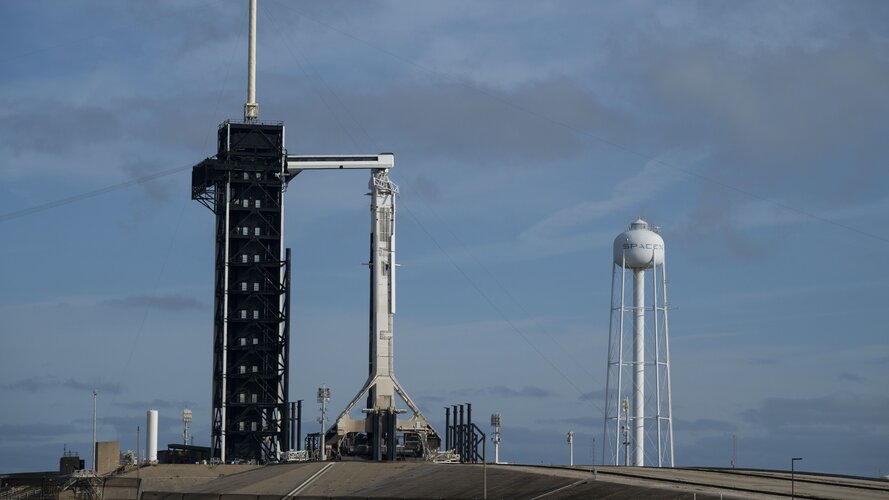
The SpaceX Dragon spacecraft sits atop a Falcon 9 rocket on Launchpad 39A at NASA’s Kennedy Space Center in Florida, USA, ready for the launch of the Axiom Mission 3 (Ax-3) to the International Space Station.
The Ax-3 launch is scheduled for 18 January at 16:49 local time (21:49 GMT/22:49 CET).
ESA project astronaut Marcus Wandt will be launched in this spacecraft alongside Walter Villadei from Italy, Alper Gezeravcı from Türkiye and Michael López-Alegría, representing both USA and Spain as a dual-citizen.
During their journey on the Dragon spacecraft to the orbital outpost Marcus and Alper will serve as mission specialists, Walter will be the crew’s pilot and Michael will be commander.
Marcus is the first of a new generation of European astronauts to fly on a commercial human spaceflight opportunity with Axiom Space. His mission is supported by ESA and the Swedish National Space Agency (SNSA).
The mission, known as Muninn, will officially begin once he enters the Station. The crew onboard will welcome the Ax-3 astronauts, including ESA astronaut Andreas Mogensen. Andreas is the current commander of the Space Station. This will be the first time two Scandinavians live and work together in space.
Marcus will devote much of his time to scientific activities and technology demonstrations that could shape the way we live and work on Earth. In total, he will run around 20 experiments during the two-week mission.
Marcus Wandt was selected in November 2022 as a member of the ESA astronaut reserve after a year-long selection process. The 2022 ESA recruitment campaign received over 22 5000 applications from across its Member States.
Follow Marcus’s journey on the Muninn website, check our launch kit and connect with him on his Instagram and X accounts.
Good advice for Marcus Wandt’s Muninn Mission
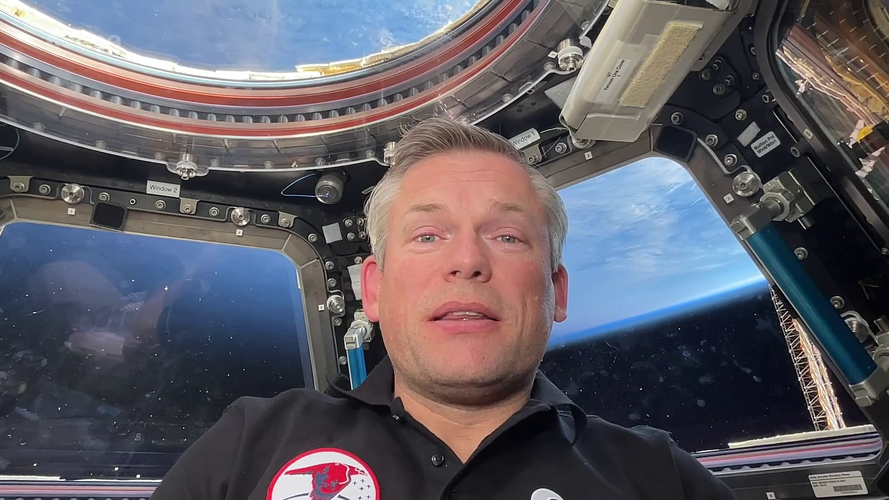
ESA astronaut and commander of Expedition 70 Andreas Mogensen has some advice for Marcus Wandt, ESA’s first project astronaut, who will join him on the International Space Station on his Muninn mission. It will be the first time two Scandinavians are in space together, which fits perfectly with their mission names, Huginn and Muninn.
Page 2 de 3
- Précédente
- 1
- 2
- 3
- Suivante



